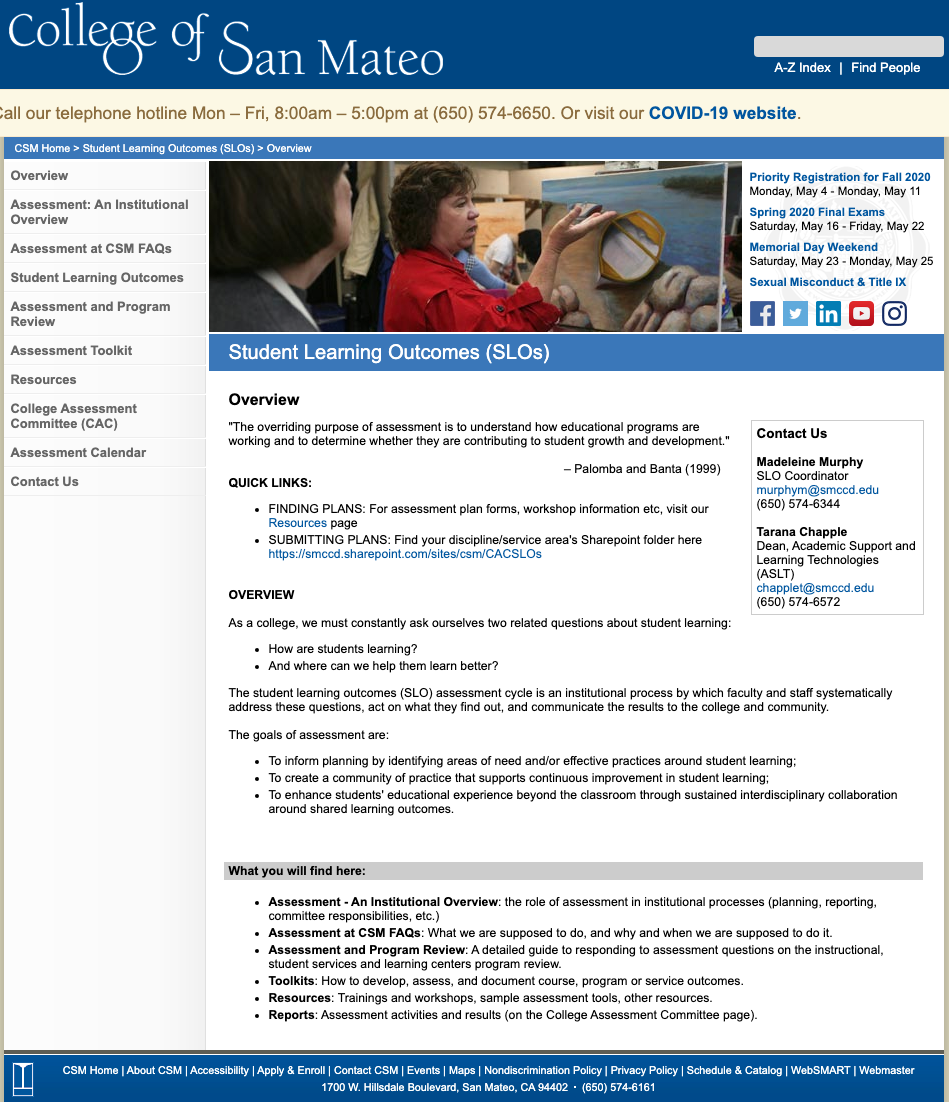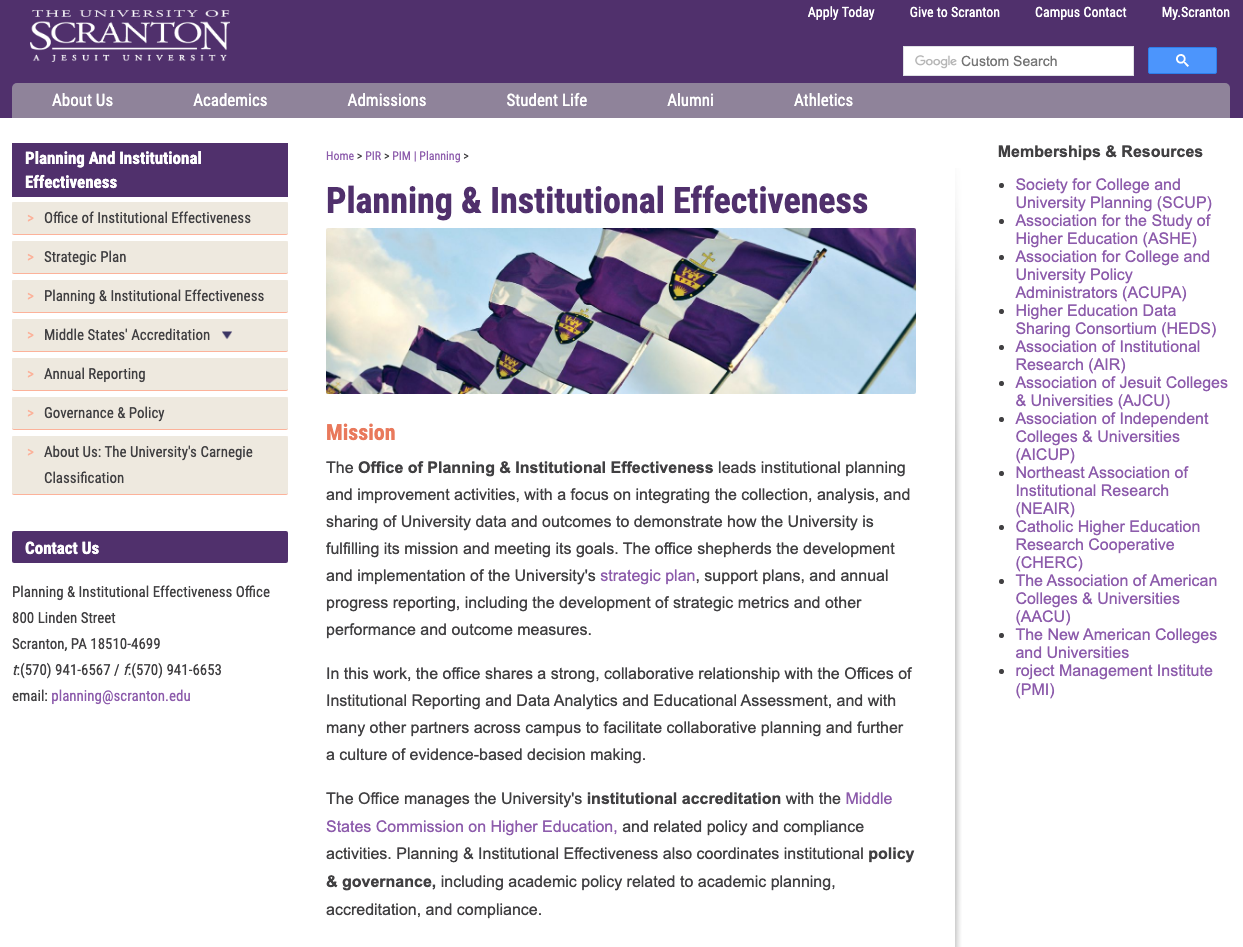Assessment Plans
Plans for gathering evidence of student learning might include institution-wide or program specific approaches that convey how student learning will be assessed, the data collection tools and approaches that will be used, and the timeline for implementation. Transparent assessment plans are:
- Descriptive of institutional assessment processes, procedures and activities
- Inclusive of assessment measures including what they are, how they are applied, and frequency of gathering evidence
- Clearly expressed and understandable by multiple audiences
- Prominently posted or linked to multiple places across the website
- Updated regularly to reflect current activities
- Downloaded or accessed in a timely fashion by multiple web browsers and download speeds
- Receptive to feedback or comments on the quality and utility of the information provided
Institutional Examples
The Student Learning Outcomes webpage from the College of San Mateo (CSM) is NILOA’s May 2020 Featured Website. Three main goals are listed for assessment: (1) To inform planning by identifying areas of need and/or effective practices around student learning; (2) To create a community of practice that supports continuous improvement in student learning; and (3) To enhance students’ educational experience beyond the classroom through sustained interdisciplinary collaboration around shared learning outcomes. To actualize the goals, the CSM provides an overview page discussing responsibilities for assessing, where assessment happens, and frequently asked questions about assessment. The college’s 6 institution-wide learning outcomes are listed, along with detailed information defining the learning outcome and expected knowledge. Website visitors can explore the learning outcomes statements and assessment measures for student services departments, including the Assessment Services/Welcome Center, Career Services, the Disability Resource Center, as well as find meeting summaries from the College Assessment Committee.
The Assessment Toolkit walks users through the development of learning outcomes, assessing outcomes, and documenting/reporting. CSM also offers resources on program review, including insight on the purpose of program review and information for the review of instruction and student services. Finally, visitors can find general assessment resources including assessment plan templates, guides, and various workshops along with CSM’s assessment calendar to help inform their practice. For these reasons, the College of San Mateo’s Student Learning Outcomes webpage is a Featured Website in the category of Centralized Assessment Repository aligning with the Transparency Framework’s component of Assessment Resources and Assessment Plans.
The University of Scranton’s Institutional Effectiveness webpage has a plethora of useful resources, including various institutional survey and research reports, institutional learning outcomes statements, assessment videos, and data on the institution’s high-impact practices (HIPs). The university’s Integrated Planning & Institutional Effectiveness Model displays how the institution’s mission and vision are supported by various processes including assessment at the division, departmental, and institutional level. It is also accompanied by a glossary of terms that can provide insight for those new to assessment. The Planning & Continuous Improvement Guide provides insight into how assessment helps the institution ensure it is meeting its strategic goals and maintaining educational quality.
There are also guides such as the data standards manual to inform gathering, reporting, and use of data, and outline the guiding principles of assessment. Website visitors can also explore the program learning outcomes for each of the University of Scranton’s current programs. Finally, external stakeholders can visit the consumer information page to find information regarding student outcomes across academic programs, cost of attendance, and institutional accreditation. The latter of which includes mapping institutional goals to Middle States Accreditation standards. For these reasons, the University of Scranton’s Institutional Effectiveness webpage is a Featured Website in the category of Centralized Assessment Repository aligning with the Transparency Framework’s component of Assessment Plans.



